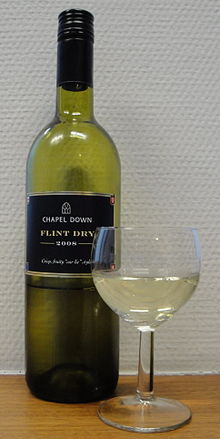Viticulture in the UK

British wine is made in small quantities in southern England and south Wales . The viticulture was favored mainly by the warmer summer in recent years. In addition, it is speculated that the vineyards could be expanded in the future as a result of global warming in this climatic border region. According English-wine.com in 2006 there were about 400 vineyards, most of which, however, are quite small, with a total area of about 2,000 acres (800 hectares ). The winegrowers, however, have problems with the mistrust of financial institutions that do not allow financing through loans.
British wine provides about one percent of the UK's household needs . A possible exit by the United Kingdom from the EU could eliminate the need for a permit for new vineyards . Since viticulture in England is benefiting from the effects of global warming , large-scale expansion of the vineyards as a result of deregulation is conceivable.
history
The Romans tried to grow wine north of Lincolnshire in their province of Britain , but the weather conditions turned out to be too cold and too humid. Even so, winemaking continued with forty vineyards up to the Normans, as mentioned in the Domesday Book . In the Middle Ages, the British market was the largest customer of sweet wines such as sherry , port and Madeira from Germany , Spain , Italy , Portugal and France .
In the 20th century
In the 1970s, wine growing started all over again due to global warming which has made many parts of Sussex , Kent , Essex , Suffolk and Cambridgeshire dry and warm enough to produce good quality wine. The first British wines, influenced by sweet German wines like Liebfrauenmilch and Hock , became very popular in the 1970s and were simply blended whites and sweet reds called cream wine (creams). The largest viticulture in England is based at Denbie's Wine Estate in Surrey , which owns 265 acres (107 hectares) of wine and a visitor center that is open year round.
British viticulture accelerated in the 1990s when wine from more atypical growing areas such as B. Australia , Chile , Argentina , New Zealand and South Africa became more and more popular and the British customer accepted more and more wine that did not come from the traditional wine-growing regions. The British wine industry emulated the new wines, producing good quality wines such as Chardonnay and Pinot Noir . In 2004, a panel that judged European sects recognized most of the top ten places for British wines - the remaining positions went to French champagnes.
Viticulture has also spread to the Midlands and Northern England, where there is a vineyard in Yorkshire and Lancashire .
Label regulations
In the UK, labeling regulations are less stringent than in the rest of Europe. Most only indicate the type of grape, the vintage, the location, the quantity and the alcohol content. This comes from the influence of wines from the new areas.
Grape varieties
Overall, you can find plantations with the grape varieties Auxerrois , Bacchus , Cascade , Chardonnay , Dunkelfelder , Ehrenfelser , Elbling , Faber , Huxelrebe , Kernling , Léon Millot , Madeleine Angevine , Merlot , Müller-Thurgau , Optima , Ortega , Pinot blanc , Pinot noir , Phoenix , Regent , Reichensteiner , Riesling , Rondo , Roter Elbling , Scheurebe , Schönburger , Schwarzriesling , Seyval Blanc and Triomphe d'Alsace .
Due to the cool wine-growing climate, the proportion of new varieties that have been adapted to this is very high.